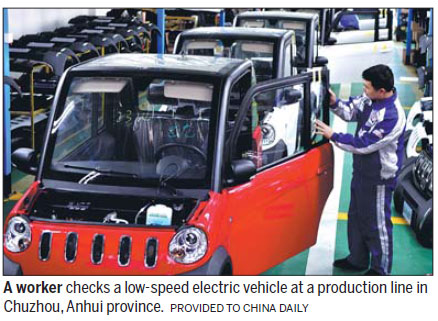New rules set to govern low-speed electric vehicles and tackle questions of safety

The Chinese government is set to plug the existing regulatory gap to update national standards for low-speed electric vehicles in a move to improve both driver and pedestrian safety and air quality.
Under the existing regulatory framework, there are no rules governing the production and sale of electric vehicles with top speeds of less than 100 kilometers per hour.
This has resulted in a large number of cheap, poorly made electric vehicles powered by polluting lead batteries, which threaten both road safety and the environment, the Ministry of Industry and Information Technology said in a statement on its website.
Many industrial experts have predicted that a number of manufacturers currently producing such low-speed vehicles could be faced with closure, as their plants and products may fall short of future requirements.
Chen Shiquan, council member of the Society of Automotive Engineers of China, said that the country is determined to regulate the small, low-speed electric vehicle sector.
The local government in Dezhou city, Shandong province, has already begun scrapping those lower quality vehicles that are unlikely to meet the new standards.
These lower quality vehicles are typically based on a welded steel frame with a stamped steel body on top, and they combine car design practices from the 1930s with modern manufacturing processes. As a result, they are the cheapest electric vehicles in the world.
They are typically small, and can be as narrow as 1.1 meters.
Taihu city in Anhui province took similar action recently.
Wang Binggang, an expert working on the Ministry of Science and Technology's new energy vehicle research project, said: "The new standards will emphasize the safety of pedestrians, of the driver and passengers in the low-speed electric vehicles, and also the safety of other road users. One of the measures to help improve safety would be the enforcement of a speed restriction on such vehicles."
Low-speed electric vehicles are currently categorized as farm vehicles for legal purposes, and may be used in suburban areas up to speeds of 70 km/h. They can, however, be manually customized to run at speeds of up to 100 km/h, and usually those who drive such vehicles are not required to hold driving licenses.
"Unlicensed drivers in a whole host of different vehicles, none of which are insured, are something we simply will not allow," Dong Yang, head of the working group drafting the new standards, wrote in an opinion piece on his public WeChat account.
These tiny vehicles that resemble golf carts have become an ever-more common sight on Chinese roads, especially in lower-tier cities, where they are replacing motorcycles due to their low cost and flexibility.
The cheapest low-speed electric vehicles sell for just $2,000.
"They are affordable. Consumers need these cheaper models in small towns, because public transportation systems there are underdeveloped," an executive of a low-speed electric vehicle manufacturer said.
Along with the cost advantages, users of low-speed electric cars can also recharge them through home power outlets, instead of charging poles.
According to local media reports, 1 million low-speed electric vehicles are produced every year, and roughly 4 million are currently running on China's roads.
The reports also said that more than 618,000 low-speed electric vehicles were delivered in Shandong province in 2016, marking growth of 47.8 percent on the previous year.
Opinions differ as to whether or not such vehicles should be governed by the same laws as passenger cars, Dong noted in his opinion piece.
China's transportation management bodies welcome such proposals, as it would ensure higher safety standards.
Passenger cars in China are regulated and managed by a series of national standards that cover safety, production and testing.
haoyan@chinadaily.com.cn




















